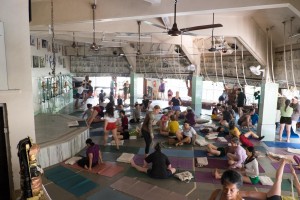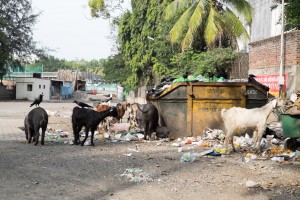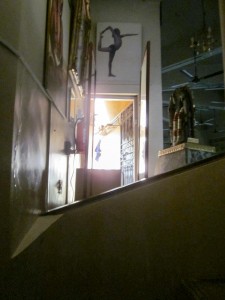It’s Monday 22nd Dec and the start of our penultimate week here in Pune, studying at the Ramamami Iyengar Yoga Institute.

Setting up our equipment for class in the yoga hall
Today’s class 7 – 9am, and Saturday’s class 7 – 9am were both extra-ordinary classes taught to us by Prashant.
I’m going to try to describe the affects here, although Prashant says there is not a dictionary of words to describe it. On Saturday Prashant’s new book on Pranayama was published at the institute so we feel very lucky to be taught by him just now and to have the book. All his classes and these 2 classes in particular, I think because they followed on from the 5 previous classes with Prashant, were revelatory for me.
I’ll start with a photograph Geoffrey took this week on the street parallel to ours. You can see the animals wander around freely and gather around the rubbish to sort through the scraps.

An important theme running through Prashant’s classes has been how we can learn from the intrinsic strengths and weaknesses of different animals. For example:
a fish
or
a vulture.
We should not be fixed, we should be open to education and to learning. Animals and humans have in some way evolved from common ancestors, obviously the more wide the difference, the further back the common ancestor might be. So humans and primates would have a common ancestor that was more recent, that humans and earthworms for example. But Prashant is asking us to consider this point, and bring particular qualities closer to us, in such a way as to call on their strengths to support our evolution of YOG. Prashant is talking about the intrinsic qualities here as well as the negative traits.
It’s all about creating the right conditions in ourselves for YOG.
So the fish, is a creature whose natural tendency is to move towards anything and gobble it up. No sooner as something lands on water the fish darts towards it and tries to eat it, even if it is not food: we know this happens to whales who swallow our plastic bottles. But in this very weakness is the fish’s strength as the fish has a natural tendency to move, to flow and to be in the moment of movement completely. It would therefore be a nonsense to describe ‘the fish standing’, ‘the fish sitting’, ‘the fish inverted’ ‘the fish lying down’ – how ridiculous – because the fish is always moving and is at one with that movement. We can learn from this in developing our “Breath Awareness” we could consider how the quality of movement and flow of the fish could help us in approaching the breath in Bharavajasana 1, or a seated twists or in any asana, the breath as a moving vehicle to explore the body. The asana can be very simple, but the affects great.
Or the moth – it always goes to the light – even to sacrifice itself. It’s wings move with speed and agility. This image reminds me of Geetaji’s children’s class where our arms felt incredibly light in a movement we normally find difficult, as we imagined the wide span of a bird wings flapping up we took our arms out to the side straight and then above our heads with our hands coming together.
There’s the ant – a creature that is different to a human in every respect, it’s an exo-skeleton. So becomes difficult to connect the human being to this, and we need to imagine some common ancestor in some pre-skeletal form. But the qualities of an ant are interesting, it can carry 10 times it’s body size in it’s jaw and them climb vertically. Yes we know, a small creature can clearly lift more, because the mechanics work better given it’s very small weight, than a bigger creature who uses all it’s energy to support itself like the elephant. The affects of gravity are the same on both creatures, but the bigger you are the greater affect of gravity. So the human being has this problem, we use so much of our energy to stand up, could we become lighter so that we could carry a heavy load? Certainly you can see this in play as we watching the women carrying very heavy loads on their heads. I’ve recently bought 2 different shaped doughnuts shapes, made of cotton belt material, used exactly for this purpose by the women. The doughnut shape sits exactly on the top of the head- the balance is perfect and totally straight. Geoffrey’s reminds me that that in Billingsgate London the fish porters used to carry the heavy fish loads in wicker baskets on their heads. The weight of the sticks or vegetables we see carried here in Pune on a woman’s head is supported down through the neck, spine and then through the hips and the legs and through the ankles and feet to the ground, a series of structures of support. By carrying ourselves absolutely vertically, which we learn in tadasana, and then sirsasana, we reduce the negative affects of gravity upon us. In sirsasana, as gravity pulls us down, we focus on the lift in the shoulders away from that and we use our legs to lift our bodies up, we ascend upwards and perhaps we can feel momentarily light like the ant!
Certainly the intrinsic difference between Geoffrey’s Sirsasana and mine, is the sense of lightness.
In the same way, we must look at the negative tendency’s in ourselves as human beings and avoid them. Prashant describes how we judge people on their profession ‘What does she/he do?’ He describes how if the answer came ‘doctor’ ‘teacher’ ‘scavenger’ what would our reaction be. Social status is attributed to professions. But a person on the path of YOG can be anything, he or she can be a scavenger or a barber, their value is not attributed to their profession the path of YOG has in itself an intrinsic value.
Here Prashant talked about ‘The Teacher’. The teacher has a special ability to be critical, to spot what is wrong. This could be a strength but it can also be a weakness, the Iyengar teacher he said, is like the vulture, with a quick eye for mistakes, it feeds on what is wrong.
The Iyengar teacher is a supreme fault finder.
Even when there is nothing wrong the Iyengar teacher will find something to point out, and this is how we are trained. In our own practice we feed on our own mistakes and occupy ourselves with actions to put them right ‘my right hamstring is tighter than my left one so I need to put it right’ etc. What follows is a passion for ‘photography yoga’, the perfect asana performed, etc. But this kind of pursuit is not YOG,
We have become stuck in action, and not ‘being’.
After every action there needs to be some time for ‘being’, so in the asana itself we should find a moment of quiet, where we stop pursuing the ‘perfect action’ and instead ‘be’. Of course there is a need to learn the asana, but after 15 years, 20 years, 30years, 40years we should not be caught in this practice, we need to start to change.
Prashant says that he is clearly ‘teaching’ us as a group of experienced practitioners, he does not correct our asana directly, he guides us to increase our awareness within that asana. He allows us to explore the asana with the breath. I’m not sure where I am going but I have found a couple of ways in which I can do it
Using action of arms and legs to bring a particular breath focus or cluster of breath focuses.
1. So for example in setu bandha with a brick. I find this very difficult with legs straight as I feel a catch in my back after too long. So I explored how I could descend the thighs down, making the groins descend and how when the abdomen also descended from there, that I could access 2 channels (Nardis) that Prasant has brought our attention to. The deep exhalation was useful here, as I found mulla kriya and then on the inhalation the sense of the breath going up the front body in clusters on the inhalation up to the collar bones to Jalandhara bandha. In such a way with the breath as my aid I found space in my back body.
In parallel
2. Every now and again Prashant encourages us to stop ‘doing’ and ‘be’. In this state, I held the work I was doing stable, and I remembered Geetaji talking about the lock, locking down the energy so that it didn’t escape. I found the inhalation very helpful here, as at the top of the inhalation in Jalandhara Bandha the pause / wait supported me to notice and then experience the pose.
It’s hard to describe but I think that in any asana, it is possible to utilise the breath to explore it from many many perspectives. More external reflections on the asana as a whole, subjective experience of a part or parts of it, or dynamic actions to facilitate a change of direction in thinking or a paradigm shift of focus. Each time breath awareness is the guide.
Today in viparitta dandasana over a char with legs in padmasana, he suggested that we did not use a characteristic ‘male force’ to push ourselves to a new limit, but instead we used the breath. He went on to say that women in Iyengar yoga were using too much of the male force to achieve the asana and that we were loosing a natural and useful quality: a natural submissiveness, which could aid us in ‘being’ and experiencing YOG. Too much of an aggressive push, to take us beyond our limits, results in a grave loss here. So we should use the breath as that energetic force instead, and use the arms and legs to get access to it.
Breath Aware, Breath Aware, Breath Aware.
I found this particularly useful, as I knew that I had been using that ‘male’ energy to work on Ustrasana and take my hands down to the soles of my feet – yes going beyond a previous limit but not in the right way. I found that when focusing on using my legs for breath awareness, I could broaden the back body and the sacrum area as I took the breath there and on so doing could find the movement in ‘being’ in the pose on ‘doing’ the pose.
It’s difficult to describe, but one thing Prashant said was that we should not learn ‘what’ he is teaching but instead learn what he is ‘trying’ to teach. This is difficult to understand but Prashant is very clear, he says
“I am not your teacher I am your guide” Prashant describes himself as a teacher by proxy, not by choice.
Going back to saturday for a moment where he explained how he felt about being a teacher. Prashant explained to us why he only teachers 4 classes a week, this he has done right from the beginning. Often he has been questioned on this, and even by his father BKS Iyengar, but he describes again the negative tendency of the Iyengar teacher – ‘the one who feeds like a vulture on criticism of others’. Prashant says that he has resisted teaching more, he has resisted traveling all over the world to teach, and he will not teach more classes, this is because he needs to hold himself in check. If he teaches for 2 hours, he needs 6 hours to recover from the negative affects of teaching. He knows that the vulture will arise in him and he works on himself to suppress it. This for me was the most extra-ordinary moment of insight, one could see in his face and eyes that he spoke the truth, he was quietly passionate about this point and the whole class heard him. It was interesting as a large number of the regular group weren’t there to hear this, because they were attending the alternative women’s class, so the group was smaller and comprised of a high proportion of men. At the end of the class, things had changed, it was palpable. Namely a number of the more arrogant strutting blokes who show off their fab poses and go round strongly assisting in the medical classes appeared to have undergone a change: they sat quietly alone after class and appeared more reflective. And for me I just felt tears of appreciation, and happiness at having heard him – this is really what we need.
I’ll leave you for now with a photograph of the view as we go up the stairs to the yoga hall, you can see the back of the Patanjali statue and a picture of BKS Iyengar.
In my next blog I’ll try and write bit more about why Prashant feels that a cook has the closest affinity with YOG, because it needs patience. And of course I think of Geoffrey and him baking our bread these 11 or so years!
Interestingly he also said that being an administrator breeds impatience – he could be talking about bureaucracy too, and to that I wonder what happens to us who work in the arts, ground down eventually by pursuing funds, organising future project, counting up the money and audience figures as we justify past projects, and often feeling frustrated by not doing enough, not growing enough, and then competing with others as we find faults in ourselves and others.

